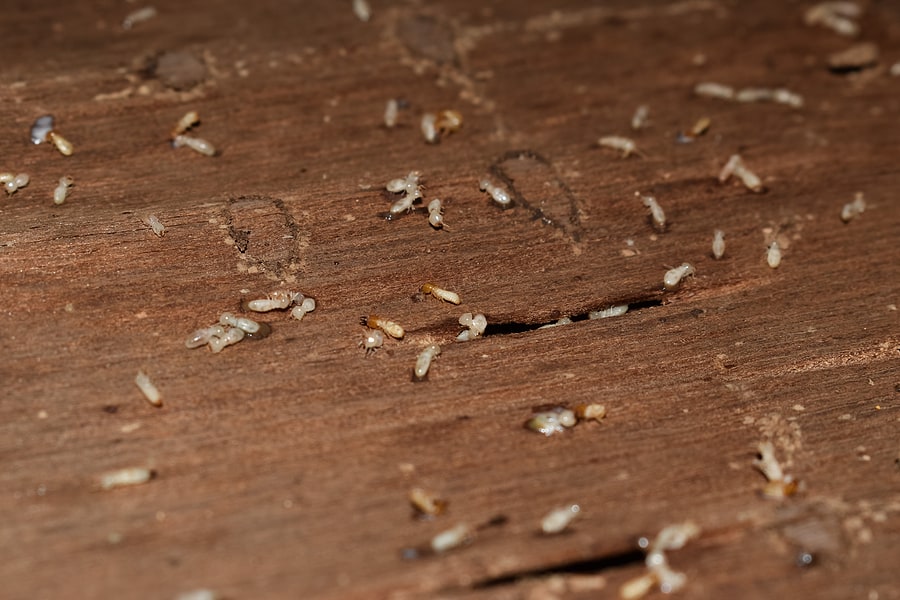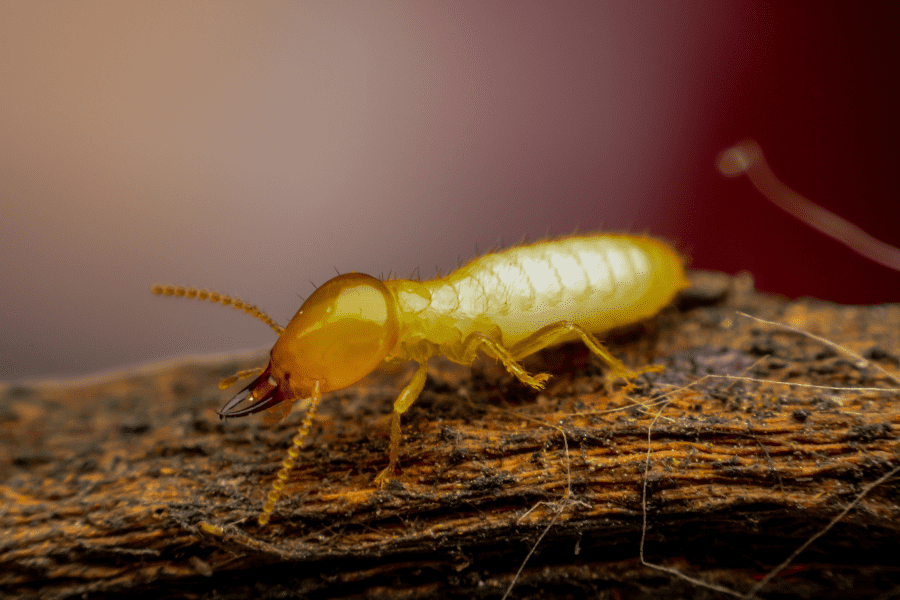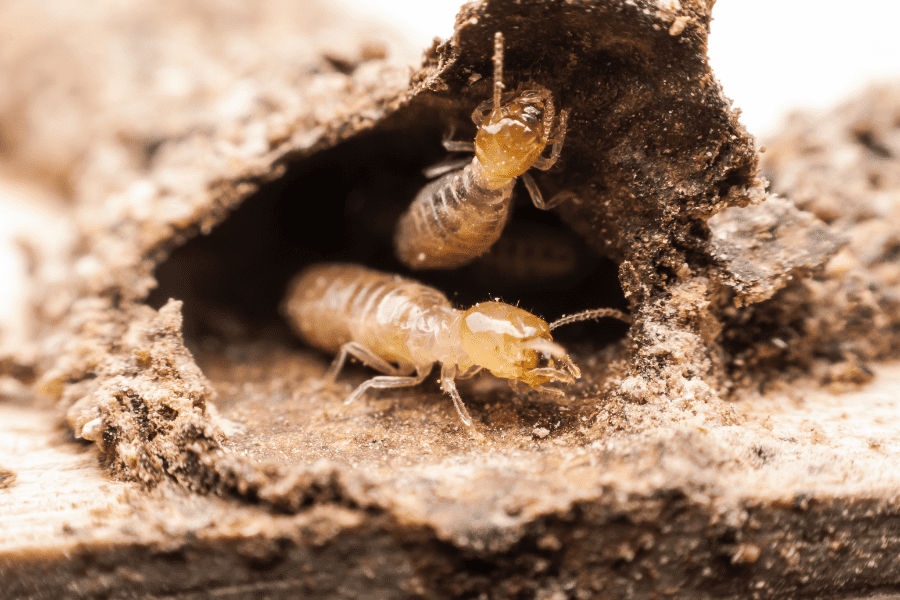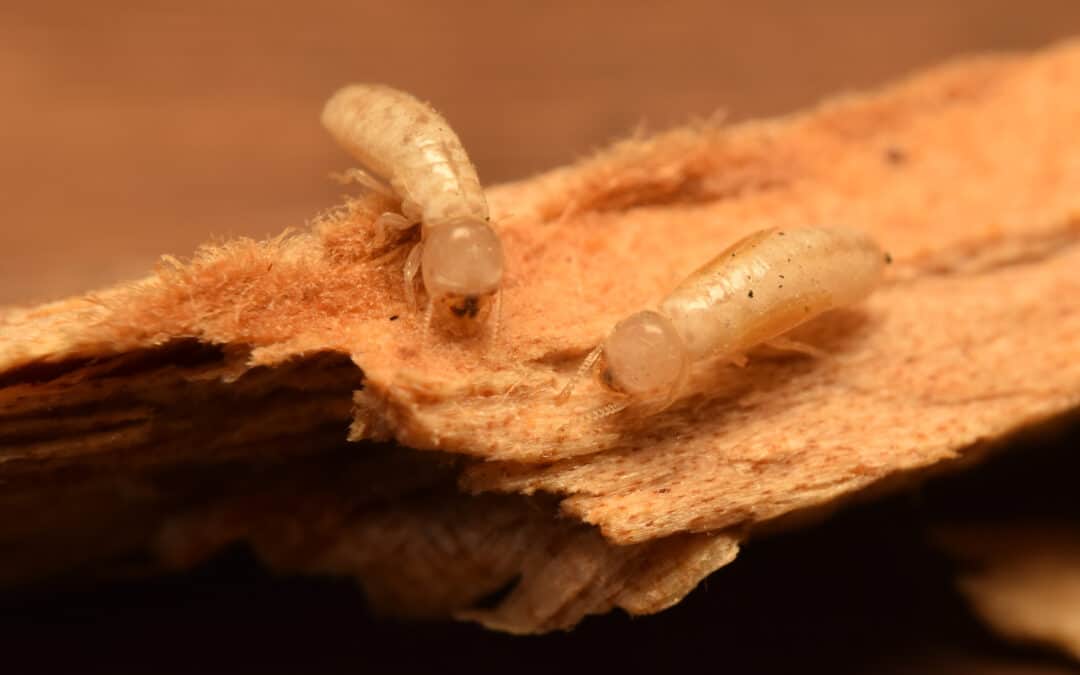READY TO GET STARTED?
REQUEST A FREE ESTIMATE
Fill out the form below or call (888) 466-7849 for a free, no-obligation estimate.

Termites will not stop until they find a food source for their colony, often destroying our homes in the process. A termite infestation can be devasting, as their damage can cost billions of dollars in repair. One of the best ways to avoid their damage is investing in termite control for your Alabama home. Let’s review the signs of termites and the several types of termite treatment options available so you can avoid their devastation.
Termites are silent destroyers, meaning they can go unnoticed for extended periods. However, there are many ways that you can tell you have a termite infestation.
When investing in termite treatment and prevention options, there are three common types of professional treatments that every homeowner should know, including bait stations, liquid-soil treatments, and wood treatments.
If you’re interested in these termite treatment options, consider contacting your local pest control company for more information. These professionals can provide you with a comprehensive inspection and help determine the best termite control plan for you and your home.

There are two factors to consider when looking at termite control: preventing them from infesting your home and treating established termite colonies. Termites are year-round pests and can go undetected for a long period of time, causing devastating damage in the process. There are several prevention methods to consider when looking to eliminate or prevent termites from your Laurens home.
One of the best and most effective ways to keep termites out is to remove any access inside your home, including gaps around water and gas lines where they enter your home. Likewise, inspect your foundation for cracks or openings and repair them immediately.
To survive, termites need wood and moisture. Eliminating these factors can help reduce your chance of a termite infestation. If you place mulch against your foundation for landscaping purposes, you could be attracting termites into your home. Mulch is a great source of food for termites as they retain any moisture. Try to minimize the use and keep it at least 15 inches away from the foundation. Additionally, if your crawlspace is experiencing a lack of airflow, it can create an ideal environment for these pests. Consider enclosing your crawlspace to prevent these termites and improve the overall health of your home by reducing moisture and decreasing humidity.
Termites can be tricky to control and eliminate! These pests will cause significant damage to your home, sometimes before you even realize they have infested. Placing preventative measures in your home to reduce the chance of a termite infestation will always help, but sometimes it’s best to leave it up to your local Laurens pest control company. These professionals can perform an annual termite inspection and provide you with the best termite control and prevention options for your home.
Spring brings warm weather and the need for spring cleaning. When making your spring to-do list, make sure to include pest control with it. The warm weather brings pests out in droves, whether emerging from their overwintering spots or searching for a mate to reproduce with. One of the most common spring pests are termites. Spring marks the beginning of termite swarming season, when termites leave their colonies in search of a mate to form a new colony with. Don’t forget to make termite treatment a priority on your spring checklist!
Termites can go undetected for long periods of time, causing significant damage to your home. Once you identify the signs of termites, the next step is to determine the best termite treatment for your situation. Here are some of the most common termite treatment options:
Pretreatments are termite treatments carried out during the construction phase of new construction. It is also preferable to use pretreatments when building additions to an existing home. When used before the physical infrastructure of a home or addition is laid, pretreatments are more effective and cost-effective. Pretreatments typically consist of a combination of liquid termiticide (often containing borates), termite bait, lumber treatment, and in-soil barriers.
Barrier treatments create a physical barrier between termites and your home. A trench is dug around your home’s perimeter, and the soil that is removed is heavily treated with a termiticide. The treated soil is then refilled into the trench. In some cases, a physical wall made of rock, sand, mesh, and plastic is built inside the trench’s outer wall. This adds another layer of defense between your home and termites.
The most common termite treatments are liquid treatments. These treatments are effective for termite infestations in your home’s interior. Holes are strategically drilled in both the foundation and the wood in these treatments. The termites are then forced to emerge after termiticide is injected into the holes. Termites are then exterminated using termiticide spot treatments.
Bait stations containing termiticide-laced wood, paper, or cellulose are placed in the ground around your home. Termites are drawn to the bait and consume it. The termiticide is slow acting, allowing termites to return to the colony and spread the bait to others, effectively killing the colony. Bait stations can be used in places where surface treatments cannot be used, such as near foundation drains and areas covered by slabs or flooring. Bait stations are a long-term and effective treatment solution.
While it can be tempting to attempt termite control yourself, it is usually best left to the professionals. If you have a termite infestation, contact your local pest control company for a termite inspection to determine the best treatment options for your home.
How to Manage Your Lawn & Prevent Lawn Diseases

Termites are known as silent destroyers, meaning they can go undetected for a long period of time, making their destruction devasting. Common termite species, such as subterranean termites, will infest our Augusta homes and damage the infrastructure, costing billions of dollars in repair. It can be difficult to detect subterranean termites, often hiding until the damage is done, but it is possible. To prevent termites, every homeowner should recognize signs of termite infestations. Check out our top 5 signs of termites that you might see in your home:
Often found on exterior surfaces, subterranean termites create mud tubes that allow them to move back and forth between their nest and their food source, which is often your home. These tunnels help protect termites from any predators and provide moisture for survival. Usually, mud tubes can be found wrapped around walls, ceilings, and floors. Mud tubes are common signs of termites.
Sometimes, hearing noises is your first sign of a termite infestation. Often, if a termite colony has infested your home, you can hear a faint clicking or knocking sound coming from behind walls and other voids. Termites create this noise when a soldier termite bangs their head against wood or vibrates their bodies to signal damage to their colony. When you listen closely, you can also hear termites chewing through wood.
Have you noticed hollow wood inside your home or in trees throughout your yard? If so, this is a major sign that termites have established a colony on your property. These pests destroy wood from the inside out, leaving only a thin layer of wood behind. When checking for hollow wood, try tapping on the area in question. You’ll hear a hollow or paper sound, indicating an infestation. Other signs include blistering or bubbling paint in or near wood structures, including windows and door trims.
Frass is the name for the waste termites leave behind. When subterranean termites travel through wood, they will push debris and waste out behind them through tiny openings. You may notice small black marks or a dark powdery substance around the infested area with small piles of sawdust-like droppings. These sawdust droppings are frass and are usually the color of the structural wood infested.
The most obvious sign of a termite infestation is seeing the damaged wood itself. Floor, window, and door damage is a major indication that termites are inside. Another indication includes windows and doors not opening or closing smoothly. Take note of any floors that buckle or sag and have them inspected.
If you’ve noticed any of these termite signs or damage, consider contacting your pest control company for a thorough inspection and treatment plan before any more termite damage is done.

Being ready for termites is your first step in preventing them. Termites can go undetected for long periods, creating extreme damage to the structural integrity of your home. In Tennessee, the most common termite species you’ll find include subterranean termites and drywood termites. The type of termite treatment option you need for a termite infestation will depend on your situation, its location, and the type of termite you have. Check out the most common termite treatments in your area below!
Performed in new construction homes, this treatment is utilized during the building phase of a home. Pretreatments are a combination of liquid termiticide, termite bait, lumber treatment, and in-soil barriers. These treatments are known to be effective and affordable when performed before the physical infrastructure or addition is laid.
Bait stations are placed in the ground and around your home to protect against termites. These stations contain wood, paper, or cellulose that has termiticide. Once termites reach the bait station, they eat the slow-acting termiticide, which allows termites to bring it to their colony and spread it, killing off the entire colony. This treatment is best used in locations where surface treatments will not work, including near foundation drains and areas covered by slabs or flooring.
This long-term treatment gets its name from the literal barrier in the ground between the termites and your home. A barrier treatment is performed by digging a trench around the perimeter of your home and then treated with termiticide. The trench is then refilled with the treated soil to help deter termites away from your home. Sometimes, a physical wall can be built inside the outer wall of the trench, made up of rock, sand, mesh, and plastic. The wall can add another layer of protection between your home and termites.
One of the most common termite treatments is liquid treatment. This option is effective when termites are in the interior of your home. The first step in the treatment is performed by drilling holes in the foundation and wood. Then, the termiticide is injected into the holes that will force termites to emerge. After emerging, the termites will be eliminated by spot treatments with termiticides.
The last thing you want to deal with is a termite infestation, as they can be difficult to get rid of once they’re inside. Consider reaching out to your local termite and pest control company for a termite inspection. These professionals will recommend the best prevention plan to avoid termites in the future. Likewise, if you suspect you have a termite infestation, they will identify the type of termite you have and provide the best termite control option for your situation.